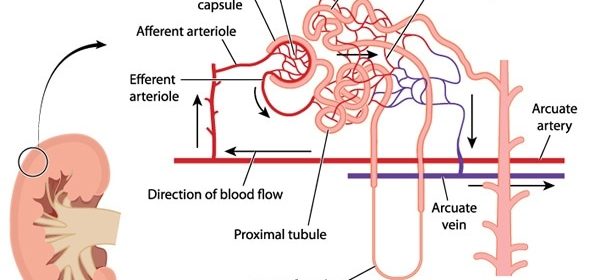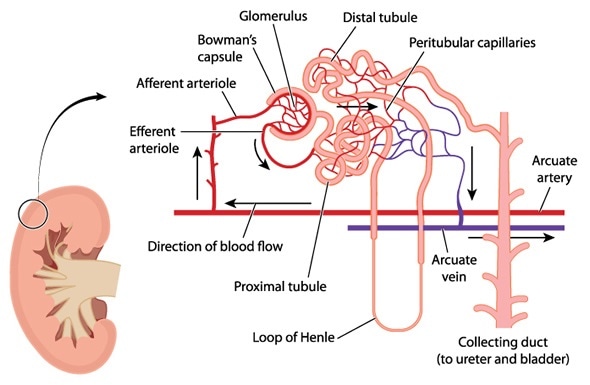The Loop of Henle

The human kidney is made up of about a million nephrons, the filtering units of this complex and highly vascular organ. Each nephron is composed of a highly coiled tubule, one end of which forms a cup-shaped structure.
Inside this cup and forming a network around its walls, is a tuft of capillaries called a glomerulus, with a special fenestrated basement membrane.
Each glomerulus filters out water and solutes from the blood passing through it into the surrounding space, which is the cavity between the two walls of the cup. This part is wholly within the renal cortex.
The next part of the tubule is highly coiled (the proximal convoluted tubule) and empties into a U-shaped loop which carries the filtered fluid deep down into the medulla and then back again into the cortex. This part of the nephron is called the loop of Henle.
Its main function is to reabsorb water and sodium chloride from the filtrate. This conserves water for the organism, producing highly concentrated urine.

Components
The loop of Henle has a thin descending limb, a thick ascending limb and a thin ascending limb.
The fluid entering the descending limb contains sodium chloride and other salts, urea and other chemicals that have been filtered out from the blood.
The cells here are permeable to water and thus the salt and urea concentration rises within the fluid by the time it reaches the bend.
The ascending limb is permeable to sodium chloride, which passes out of the tubule into the medullary tissue surrounding it.
Functions
The absorption of water within the descending limb leads to an increasing osmotic gradient within the tubule by increasing the solute concentration.
Simultaneously, the active transport of sodium chloride into the interstitium through the water-impermeable cells of the ascending limb maintains the gradient by ensuring that the concentration declines as the fluid passes towards the distal convoluted tubule.
The loop of Henle is supplied by two vasa recta which are straight vessels closely accompanying the tubule’s hairpin-shaped course.
These carry blood in opposite directions, just like the passage of tubular fluid – the countercurrent mechanism. Thus they absorb water on the one hand and solute on the other.
This is called the countercurrent multiplier system, which is responsible for maintaining an osmotic medullary gradient in the outer medullary tissue. This gradient ensures the vasopressin-driven reabsorption of water from the luminal fluid in the collecting duct.
The thick ascending limb expresses a sodium-potassium-chloride cotransporter and helps reabsorb approximately a third of the filtered sodium and chloride from the fluid in the tubular lumen into the blood.
Other functions of the loop of Henle include:
- Homeostatic mechanisms to regulate the extracellular fluid volume
- Regulating potassium, calcium and magnesium excretion at the lowest energy costs
- Homeostasis of the acid-base balance via bicarbonate and ammonia excretion
- Regulating the composition of urinary protein
References
- http://www.niddk.nih.gov/research-funding/at-niddk/labs-branches/kidney-disease-branch/kidney-diseases-section/glomerular-disease-primer/-normal-kidney/Pages/normal-kidneys.aspx
- http://www.ncbi.nlm.nih.gov/pmc/articles/PMC4220766/
- http://www.sciencedirect.com/science/article/pii/S0085253815328337
Further Reading
- All Nephrology Content
- Nephrology – What is Nephrology?
- Nephrologist – What is a Nephrologist?
- When to see a Nephrologist
- Nephrology Diagnosis
Last Updated: Feb 27, 2019

Written by
Dr. Liji Thomas
Dr. Liji Thomas is an OB-GYN, who graduated from the Government Medical College, University of Calicut, Kerala, in 2001. Liji practiced as a full-time consultant in obstetrics/gynecology in a private hospital for a few years following her graduation. She has counseled hundreds of patients facing issues from pregnancy-related problems and infertility, and has been in charge of over 2,000 deliveries, striving always to achieve a normal delivery rather than operative.
Source: Read Full Article